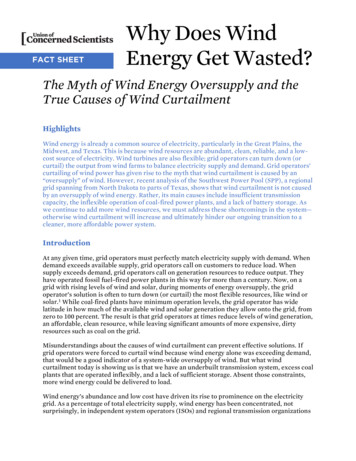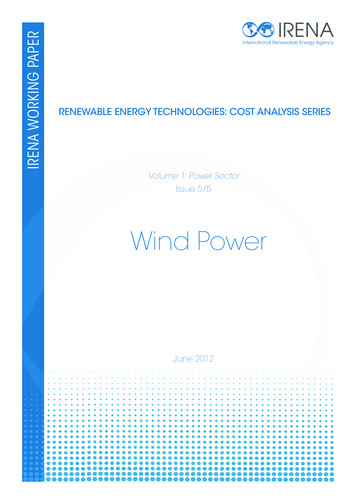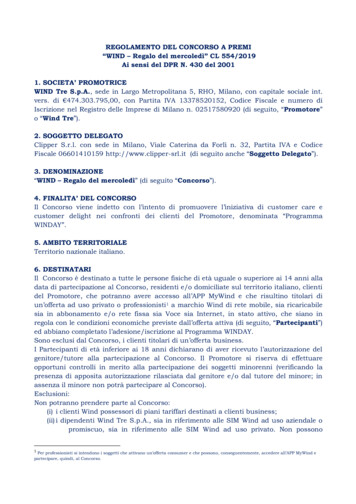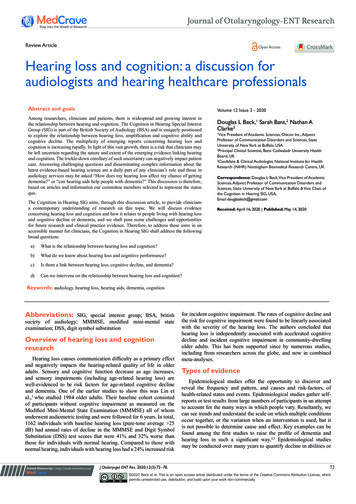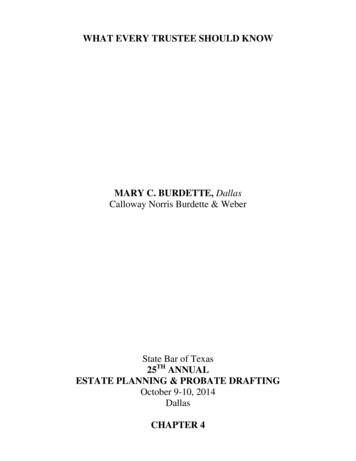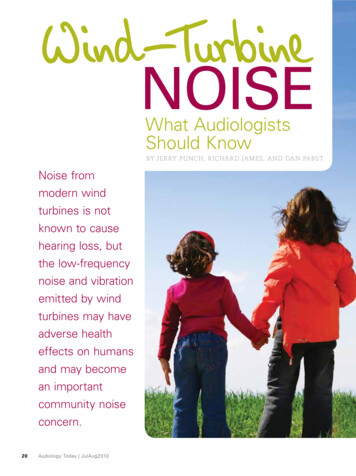
Transcription
NoiseWhat AudiologistsShould KnowBy Jer ry Pu nch, Rich a r d James, a nd Da n PabstNoise frommodern windturbines is notknown to causehearing loss, butthe low-frequencynoise and vibrationemitted by windturbines may haveadverse healtheffects on humansand may becomean importantcommunity noiseconcern.20Audiology Today JulAug2010
JulAug2010 Audiology Today21
Wind-Turbine Noise: What Audiolog ists Should Knowost of us would agree that the modern wind turbine is a desirablealternative for producing electrical energy. One of the most highlytouted ways to meet a federal mandate that 20 percent of allenergy must come from renewable sources by 2020 is to installlarge numbers of utility-scale wind turbines. Evidence has beenmounting over the past decade, however, that these utility-scalewind turbines produce significant levels of low-frequency noiseand vibration that can be highly disturbing to nearby residents.None of these unwanted emissions, whether audible orinaudible, are believed to cause hearing loss, but theyare widely known to cause sleep disturbances. Inaudiblecomponents can induce resonant vibration in solids, liquids, and gases—including the ground, houses, and otherbuilding structures, spaces within those structures, andbodily tissues and cavities—that is potentially harmfulto humans. The most extreme of these low-frequency(infrasonic) emissions, at frequencies under about 16 Hz,can easily penetrate homes. Some residents perceive theenergy as sound, others experience it as vibration, andothers are not aware of it at all. Research is beginning toshow that, in addition to sleep disturbances, these emissions may have other deleterious consequences on health.It is for these reasons that wind turbines are becomingan important community health issue, especially whenhosted in quiet rural communities that have no priorexperience with industrial noise or urban hum.The people most susceptible to disturbances causedby wind turbines may be a small percentage of the totalexposed population, but for them the introduction ofwind turbines in their communities is not something towhich they can easily become acclimated. Instead, theybecome annoyed, uncomfortable, distressed, or ill. Thisproblem is increasing as newer utility-scale wind turbines capable of generating 1.5-5 MWatts of electricityor more replace the older turbines used over the past 30years, which produced less than 1 MWatt of power. Theselarge wind turbines can have hub heights that span thelength of a football field and blade lengths that span halfthat distance. The increased size of these multi-MWattturbines, especially the blades, has been associated withcomplaints of adverse health effects (AHEs) that cannotbe explained by auditory responses alone.For this article, we reviewed the English-language,peer-reviewed literature from around the world on thetopic of wind-turbine noise and vibration and their effectson humans. In addition, we used popular search enginesto locate relevant online trade journals, books, referencesources, government regulations, and acoustic and vibration standards. We also consulted professional engineersand psychoacousticians regarding their unpublishedideas and research.Sources of Wind-Turbine Noise andVibrationMajor components of a modern wind turbine.22Audiology Today JulAug2010Physically, a modern wind turbine consists of a tower;a rotor (or hub); a set of rotating blades—usually three,located upwind to the tower; and a nacelle, which isan enclosure containing a gearbox, a generator, and
Wind-Turbine Noise: What Audiolog ists Should Knowcomputerized controls that monitor and regulate operations (Figure 1). Wind speed can be much greater at hublevel than at ground level, so taller wind towers areused to take advantage of these higher wind speeds.Calculators are available for predicting wind speed at hubheight, based on wind speeds at 10 meter weather towers,which can easily be measured directly.Mechanical equipment inside the nacelle generatessome noise, but at quieter levels than older turbines. Thismechanical sound is usually considered of secondaryimportance in discussions of annoyance from today’s turbines. The main cause of annoyance is an aerodynamicsource created by interaction of the turning blades withthe wind. With optimal wind conditions, this aerodynamic noise is steady and commonly described as anairplane overhead that never leaves.When wind conditions are not optimal, such as duringturbulence caused by a storm, the steady sounds are augmented by fluctuating aerodynamic sounds. Under steadywind conditions, this interaction generates a broadbandwhooshing sound that repeats itself about once a secondand is clearly audible. Many people who live near thewind turbine find this condition to be very disturbing.The whooshing sound comes from variations of airturbulence from hub to blade tip and the inability of theturbine to keep the blades adjusted at an optimal angle aswind direction varies. The audible portion of the whooshis around 300 Hz, which can easily penetrate walls ofhomes and other buildings. In addition, the rotatingblades create energy at frequencies as low as 1–2 Hz (theblade-passage frequency), with overtones of up to about20 Hz. Although some of this low-frequency energy isaudible to some people with sensitive hearing, the energyis mostly vibratory to people who react negatively to it.Studies carried out in Denmark, The Netherlands, andGermany (Wolsink and Sprengers, 1993; Wolsink et al,1993), a Danish study (Pedersen and Nielsen, 1994), and twoSwedish studies (Pedersen and Persson Waye, 2004, 2007)collectively indicate that wind turbines differ from othersources of community noise in several respects. Theseinvestigators confirm the findings of earlier research thatamplitude-modulated sound is more easily perceived andmore annoying than constant-level sounds (Bradley, 1994;Bengtsson et al, 2004) and that sounds that are unpredictable and uncontrollable are more annoying than othersounds (Geen and McCown, 1984; Hatfield et al, 2002).Annoyance from wind-turbine noise has been difficultto characterize by the use of such psychoacoustic parameters as sharpness, loudness, roughness, or modulation(Persson Waye and Öhrström, 2002). The extremely lowfrequency nature of wind-turbine noise, in combinationwith the fluctuating blade sounds, also means that thenoise is not easily masked by other environmental sounds.Pedersen et al (2009), in a survey conducted in TheNetherlands on 725 respondents, found that noise fromAdverse Health Effects of WindTurbine NoiseHubbard and Shepherd (1990), in a technical paperwritten for the National Aeronautics and SpaceAdministration (NASA), were the first to report in depthon the noise and vibration from wind turbines. Most ofthe relevant research since that time has been conductedby European investigators, as commercial-grade (utilityscale) wind turbines have existed in Europe for manydecades. Unfortunately, the research and developmentdone by wind-turbine manufacturers is proprietary andtypically has not been shared with the public, but reportsof the distressing effects on people living near utilityscale wind turbines in various parts of the world arebecoming more common.JulAug2010 Audiology Today23
Wind-Turbine Noise: What Audiolog ists Should Knowwind turbines is more annoying than transportation orindustrial noises at comparable levels, measured in dBA.They noted that annoyance from turbine sounds at 35dBA corresponds to the annoyance reported for othercommon community-noise sources at 45 dBA. Highervisibility of the turbines was associated with higherlevels of annoyance, and annoyance was greater whenattitudes toward the visual impact of the turbines on thelandscape were negative. However, the height of windturbines means that they are also most clearly visible tothe people closest to them and those who also receivethe highest sound levels. Thus, proximity of the receiverto wind turbines makes it difficult to determine whetherannoyance to the noise is independent of annoyance tothe visual impact. Pedersen et al (2009) also found thatannoyance was substantially lower in people who benefitted economically from having wind turbines locatedon their property.Among audiologists and acousticians, it has beenunderstood for many decades that sufficiently intenseand prolonged exposure to environmental noise can causehearing impairment, annoyance, or both. In essence, theview has been what you can hear can hurt you. In thecase of wind turbines, it seems that what you can’t hearTable 1. Core Symptoms of Wind-TurbineSyndrome1Sleep disturbance2Headache3Visceral Vibratory Vestibular Disturbance (VVVD)4Dizziness, vertigo, unsteadiness5Tinnitus6Ear pressure or pain7External auditory canal sensation8Memory and concentration deficits9Irritability, anger10Fatigue, loss of motivationSource: Pierpont, 200924Audiology Today JulAug2010can also hurt you. Again, there is no evidence that noisegenerated by wind turbines, even the largest utility-scaleturbines, causes hearing loss. But there is increasinglyclear evidence that audible and low-frequency acousticenergy from these turbines is sufficiently intense to causeextreme annoyance and inability to sleep, or disturbedsleep, in individuals living near them.Jung and colleagues (2008), in a Korean study, concluded that low-frequency noise in the frequency rangeabove 30 Hz can lead to psychological complaints and thatinfrasound in the frequency range of 5–8 Hz can causecomplaints due to rattling doors and windows in homes.The energy generated by large wind turbines can beespecially disturbing to the vestibular systems of somepeople, as well as cause other troubling sensations of thehead, chest, or other parts of the body. Dr. Nina Pierpont(2009), in her definitive natural experiment on the subject,refers to these effects as Wind-Turbine Syndrome (WTS).Table 1 lists the symptoms that, in various combinations,characterize WTS. Although hearing impairment is notone of the symptoms of WTS, audiologists whose patientsreport these symptoms should ask them if they live neara wind turbine.It is well known that sleep deprivation has seriousconsequences, and we know that noncontinuous soundsand nighttime sounds are less tolerable than continuous and daytime sounds. Somewhat related effects,such as cardiac arrhythmias, stress, hypertension, andheadaches have also been attributed to noise or vibration from wind turbines, and some researchers arereferring to these effects as Vibroacoustic Disease, orVAD (Castelo Branco, 1999; Castelo Branco and AlvesPereira, 2004). VAD is described as occurring in personswho are exposed to high-level ( 90 dB SPL) infra- andlow-frequency noise (ILFN), under 500 Hz, for periods of10 years or more. It is believed to be a systemic pathology characterized by direct tissue damage to a variety ofbodily organs and may involve abnormal proliferation ofextracellular matrices.Alves-Pereira and Castelo Branco (2007) reported on afamily who lived near wind turbines and showed signsof VAD. The sound levels in the home were less than 60dB SPL in each 1/3–octave band below 100 Hz. We havemeasured unweighted sound levels ranging from 60 to 70dB Leq (averaged over 1 minute) in these low-frequencybands in Ontario homes of people reporting AHEs fromwind turbines. A spectral analysis of sounds emitted ata Michigan site revealed that unweighted peak levels atfrequencies under 5 Hz exceeded 90 dB SPL (Wade Bray,pers. comm., 2009).
Wind-Turbine Noise: What Audiolog ists Should KnowSimilar observations have been made in studies ofpeople who live near busy highways and airports, whichalso expose people to low-frequency sounds, bothoutdoors and in their homes. Evidence is insufficientto substantiate that typical exposures to wind-turbinenoise, even in residents who live nearby, can lead toVAD, but early indications are that there are some morevulnerable people who may be susceptible. Because ILFNis not yet recognized as a disease agent, it is not coveredby legislation, permissible exposure levels have not yetbeen established, and dose-response relationships areunknown (Alves-Pereira, 2007).As distinguished from VAD, Pierpont’s (2009) use ofthe term Wind-Turbine Syndrome appears to emphasize a constellation of symptoms due to stimulation, oroverstimulation, of the vestibular organs of balancedue to ILFN from wind turbines (see Table 1). One of themost distinctive symptoms she lists in the constellation of symptoms comprising WTS is Visceral VibratoryVestibular Disturbance (VVVD), which she defines as “asensation of internal quivering, vibration, or pulsationaccompanied by agitation, anxiety, alarm, irritability,rapid heartbeat, nausea, and sleep disturbance” (p. 270).Drawing on the recent work of Balaban and colleagues(i.e., Balaban and Yates, 2004), Pierpont describes theclose association between the vestibular system and itsneural connections to brain nuclei involved with balanceprocessing, autonomic and somatic sensory inflow andoutflow, the fear and anxiety associated with vertigoor a sudden feeling of postural instability, and aversivelearning. These neurological relationships give credenceto Pierpont’s linkage of the symptoms of VVVD to thevestibular system.Todd et al (2008) demonstrated that the resonantfrequency of the human vestibular system is 100 Hz,concluding that the mechano-receptive hair cells of thevestibular structures of the inner ear are remarkably sensitive to low-frequency vibration and that this sensitivityto vibration exceeds that of the cochlea. Not only is 100Hz the frequency of the peak response of the vestibularsystem to vibration, but it is also a frequency at whicha substantial amount of acoustic energy is produced bywind turbines. Symptoms of both VAD and VVVD canpresumably occur in the presence of ILFN as a result ofdisruptions of normal paths or structures that mediatethe fine coordination between living tissue deformationand activation of signal transducers; these disruptionscan lead to aberrant mechano-electrical coupling thatcan, in turn, lead to conditions such as heart arrhythmias(Ingber, 2008). Ultimately, further research will be neededto sort out the commonalities and differences among thesymptoms variously described in the literature as VAD,VVVD, and WTS.Dr. Geoff Leventhall, a British scientist, and his colleagues (Waye et al, 1997; Leventhall, 2003, 2004) havedocumented the detrimental effects of low-frequencynoise exposure. They consider it to be a special environmental noise, particularly to sensitive people in theirhomes. Waye et al (1997) found that exposure to dynamically modulated low-frequency ventilation noise (20–200Hz)—as opposed to midfrequency noise exposure—wasmore bothersome, less pleasant, impacted work performance more negatively, and led to lower social orientation.Leventhall (2003), in reviewing the literature on theeffects of exposure to low-frequency noise, found no evidence of hearing loss but substantial evidence of vibrationof bodily structures (chest vibration), annoyance (especiallyin homes), perceptions of unpleasantness (pressure on theeardrum, unpleasant perception within the chest area, anda general feeling of vibration), sleep disturbance (reducedwakefulness), stress, reduced performance on demandingJulAug2010 Audiology Today25
Wind-Turbine Noise: What Audiolog ists Should Knowverbal tasks, and negative biological effects that includedquantitative measurements of EEG activity, blood pressure,respiration, hormone production, and heart rate.Regarding work performance, reviewed studiesindicated that dynamically modulated low-frequencynoise, even when inaudible to most individuals, is moredifficult to ignore than mid- or high-frequency noise andthat its imperviousness to habituation leads to reducedavailable information-processing resources. Leventhallhypothesized that low-frequency noise, therefore, mayimpair work performance. More recently, as a consultant on behalf of the British Wind Energy Association(BWEA), the American Wind Energy Association (AWEA),and the Canadian Wind Energy Association (CANWEA),Leventhall (2006) changed his position, stating thatalthough wind turbines do produce significant levelsof low-frequency sound, they do not pose a threat tohumans—in effect reverting to the notion that what youcan’t hear can’t hurt you.According to the World Health Organization guidelines(WHO, 2007), observable effects of nighttime, outdoorwind-turbine noise do not occur at levels of 30 dBA orlower. Many rural communities have ambient, nighttimesound levels that do not exceed 25 dBA. As outdoor soundlevels increase, the risk of AHEs also increases, withthe most vulnerable being the first to show its effects.Vulnerable populations include elderly persons; children,especially those younger than age six; and people withpre-existing medical conditions, especially if sleep isaffected. For outdoor sound levels of 40 dBA or higher,the WHO states that there is sufficient evidence to linkprolonged exposure to AHEs. While the WHO identifieslong-term, nighttime audible sounds over 40 dBA outsideone’s home as a cause of AHEs, the wind industry commonly promotes 50 dBA as a safe limit for nearby homesand properties. Recently, a limit of 45 dBA has been proposed for new wind projects in Canada (Keith et al, 2008).Much of the answer as to why the wind industrydenies that noise is a serious problem with its wind turbines is because holding the noise to 30 dBA at night hasserious economic consequences. The following quotation by Upton Sinclair seems relevant here: “It is difficultto get a man to understand something when his salarydepends upon his not understanding it” (Sinclair, 1935,reprinted 1994, p. 109).In recent years, the wind industry has denied thevalidity of any noise complaints by people who live nearits utility-scale wind turbines. Residents who are leasingtheir properties for the siting of turbines are generally sopleased to receive the lease payments that they seldomcomplain. In fact, they normally are required to sign aleasing agreement, or gag clause, stating they will notspeak or write anything unfavorable about the turbines.Consequently, complaints, and sometimes lawsuits, tendto be initiated by individuals who live near property onwhich wind turbines are sited, and not by those who areleasing their own property. This situation pits neighboragainst neighbor, which leads to antagonistic divisionswithin communities.Measurement of Wind-Turbine NoiseUtility-scale wind turbines located in Huron County, Michigan.26Audiology Today JulAug2010It is important to point out that the continued use of theA-weighting scale in sound-level meters is the basis formisunderstandings that have led to acrimony betweenadvocates and opponents of locating wind turbines inresidential areas. The dBA scale grew out of the desire toincorporate a function into the measurement of soundpressure levels of environmental and industrial noise thatis the inverse of the minimum audibility curve (Fletcherand Munson, 1933) at the 40-phon level. It is typicallyused, though, to specify the levels of noises that are moreintense, where the audibility curve becomes considerablyflattened, obviating the need for A-weighting. It is mandated in various national and international standards formeasurements that are compared to damage-risk criteriafor hearing loss and other health effects. The A-weightedscale in sound-level meters drastically reduces
Wind-Turbine Noise: What Audiolog ists Should Knowsound-level readings in the lower frequencies, beginningat 1000 Hz, and reduces sounds at 20 Hz by 50 dB.For wind-turbine noise, the A-weighting scale is especially ill-suited because of its devaluation of the effects oflow-frequency noise. This is why it is important to makeC-weighted measurements, as well as A-weighted measurements, when considering the impact of sound fromwind turbines. Theoretically, linear-scale measurementswould seem superior to C-scale measurements in windturbine applications, but linear-scale measurements lackstandardization due to failure on the part of manufacturers of sound-level meters to agree on such factors aslow-frequency cutoff and response tolerance limits. TheZ-scale, or zero-frequency weighting, was introduced in2003 by the International Electro-technical Commission(IEC) in its Standard 61672 to replace the flat, or linear,weighting used by manufacturers in the past.State of Michigan Siting GuidelinesMichigan’s siting guidelines (State of Michigan, 2008) willbe used as an example of guidelines that deal only in alimited way with sound. These guidelines refer to earlier, now outdated, WHO and Environmental ProtectionAgency (EPA) guidelines to support a noise criterionthat SPLs cannot exceed 55 dBA at the adjacent propertyline. This level is allowed to be exceeded during severeweather or power outages, and when the ambient soundlevel is greater than 55 dBA, the turbine noise can exceedthat higher background sound level by 5 dB. These levelsare about 30 dB above the nighttime levels of most ruralcommunities. When utility-scale turbines were installedin Huron County, Michigan, in May 2008, the WHO’s 2007guidelines that call for nighttime, outside levels not toexceed 30 dBA were already in place. Based on measurements made by the authors, these turbines produce 40–45dBA sound levels at the perimeter of a 1,000 ft radiusunder typical weather conditions, and the additive effectsof multiple turbines produce higher levels. Many of theturbines have been located close enough to homes toproduce very noticeable noise and vibration.Kamperman and James (2009) have offered recommendations for change in the State of Michigan guidelines(2008) for wind turbines. Some of the more pertinentdetails of the Michigan siting guidelines are shown inthe left-hand column of Table 2. The state of Michiganpermits sound levels that do not exceed 55 dBA or L90 5 dBA, whichever is greater, measured at the propertyline closest to the wind-energy system. These guidelinesmake no provisions to limit low-frequency sounds fromwind-turbine operations.In consideration of the current WHO guidelines (2007),measurements made by the authors in Huron County,Michigan, indicate that the current Michigan guidelinesdo not appear adequate to protect the public from thenuisances and known health risks of wind-turbine noise.In fact, these guidelines appear to be especially lenientTable 2. Current and Proposed Wind-Turbine Siting GuidelinesCurrent Michigan Guidelines*Alternative Proposed Guidelines**Sound level cannot exceed 55 dBA or L90 5dBA, whichever is greater.Operating LAeq is not to exceed the background LA90 5dBA, where LA90 is measured during a preconstruction noisestudy at the quietest time of night. Similar dBC limits shouldalso be applied.Limits apply to sound levels measured athomes (as stated in Huron County Ordinance).Limits apply to sound levels measured at property lines, exceptthat turbine sounds cannot exceed 35 dBA at any home.No provisions are made for limiting lowfrequency sounds from wind-turbineoperations.LCeq-LA90 cannot exceed 20 dB at receiving property, e.g.,LCeq (from turbines) minus (LA90 [background] 5) 20 dB,and is not to exceed 55 LCeq from wind turbines (60 LCeq forproperties within one mile of major heavily trafficked roads).*Source: State of Michigan, 2008**Source: Kamperman and James, 2009JulAug2010 Audiology Today27
Wind-Turbine Noise: What Audiolog ists Should Knowin terms of tolerable sound levels. Sound levels thatapproach 20 dBA higher than natural ambient levels areconsidered unacceptable in most countries; Michiganpermits 30 dBA increases.In considering the health and well-being of peopleliving near wind-turbine projects, the changes recommended by Kamperman and James (2009) would abandonthe 55 dBA limit in favor of the commonly acceptedcriteria of L90 5 dBA, for both A- and C-scale readings,where L90 is the preconstruction ambient level. Theserecommendations also include a prohibition against anywind-turbine-related sound levels exceeding 35 dBA onreceiving properties that include homes or other structures in which people sleep. Additional protections againstlow-frequency sound are given in the right-hand columnof Table 2. These recommended provisions would protectresidents by limiting the difference between C-weightedPeople living near windturbines may experiencesleep disturbance.Leq during turbine operation and the quietest A-weightedpre-operation background sound levels, plus 5 dB, to nomore than 20 dB at the property line. This level should notexceed 55 dB Leq on the C scale, or 60 dB Leq for propertieswithin one mile of major heavily trafficked roads, whichsets a higher tolerance for communities that tend to experience slightly noisier conditions.Implementation of the recommendations ofKamperman and James would result in siting wind turbinesdifferently than what is currently planned for future windturbine projects in Michigan. This change would resultin sound levels at nearby properties that are much lessnoticeable, and much less likely to cause sleep deprivation,annoyance, and related health risks. These sound-levelmeasurements should be made by independent acousticalengineers or knowledgeable audiologists who follow ANSIguidelines (1993, 1994) to ensure fair and accurate readings,and not by representatives of the wind industry.People living within a mile of one or more wind turbines, and especially those living within a half mile, havefrequent sleep disturbance leading to sleep deprivation,28Audiology Today JulAug2010and sleep disturbances are common in people who live upto about 1.25 miles away. This is the setback distance atwhich a group of turbines would need to be in order not tobe a nighttime noise disturbance (Kamperman and James,2009). It is also the setback distance used in several othercountries that have substantial experience with wind turbines, and is the distance at which Pierpont (2009) foundvery few people reporting AHEs.A study conducted by van den Berg (2003) in TheNetherlands demonstrated that daytime levels cannot beused to predict nighttime levels and that residents within1900 mile (1.18 mile) of a wind-turbine project expressedannoyance from the noise. Pierpont (2009) recommendsbaseline minimum setbacks of 2 kilometers (1.24 mile)from residences and other buildings such as hospitals,schools, and nursing homes, and longer setbacks inmountainous terrain and when necessary to meet thenoise criteria developed by Kamperman and James (2009).In a panel review report, the American WindEnergy Association (AWEA) and Canadian Wind EnergyAssociation (CANWEA) have objected to setbacks thatexceed 1 mile (Colby et al, 2009). A coalition of independent medical and acoustical experts, the Society for WindVigilance (2010), has provided a recent rebuttal to thatreport. The society has described the panel review as atypical product of industry-funded white papers, beingneither authoritative nor convincing. The society acceptsas a medical fact that sleep disturbance, physiologicalstress, and psychological distress can result from exposure to wind-turbine noise.Wind turbines have different effects on differentpeople. Some of these effects are somewhat predictablebased on financial compensation, legal restrictions onfree speech included in the lease contracts with hostinglandowners, and distance of the residence from windprojects, but they are sometimes totally unpredictable.Planning for wind projects needs to be directed not onlytoward benefitting society at large but also toward protecting the individuals living near them. We believe thatthe state of Michigan, and other states that have adoptedsimilar siting guidelines for wind turbines, are not actingin the best interest of all their citizens and need to revisetheir siting guidelines to protect the public from possiblehealth risks and loss of property values, as well as reducecomplaints about noise annoyance.Wind-utility developers proposing new projects to apotential host community are often asked if their projectswill cause the same negative community responses thatare heard from people living in the footprint of operatingprojects. They often respond that they will use a different
Wind-Turbine Noise: What Audiolog ists Should Knowtype of wind turbine or that reports of complaints refer toolder-style turbines that they do not use. In our opinion,these statements should usually be viewed as diversionary.Finally, it is important to note that there is little difference in noise generated across makes and models ofmodern utility-scale, upwind wind turbines once theirpower outputs are normalized. Kamperman (pers. comm.,2009), after analyzing data from a project funded by theDanish Energy Authority (Søndergaard and Madsen, 2008),has indicated that when the A-weighted sound levels areconverted to unweighted levels, the low-frequency energyfrom industrial wind turbines increases inversely withfrequency at a rate of approximately 3 dB per octave tobelow 10 Hz (the lowest reported frequency). Kampermanhas concluded that the amount of noise generated at lowfrequencies increases by 3–5 dB for every MW of electricalpower generated. Because turbines are getting larger, thismeans that future noise problems are likely to get worse ifsiting guidelines are not changed.ConclusionOur purpose in this article has been to provide audiologists with a better understanding of the types of noisegenerated by wind turbines, some basic considerationsunderlying sound-level measurements of wind-turbinenoise, and the adverse health effects on people who livenear these turbines. In future years, we expect that audiologists will be called upon to make noise measurementsin communities that have acquired wind turbines, or areconsidering them. Some of us, along with members of themedical profession, will be asked to provide legal testimony r
turbines, causes hearing loss. But there is increasingly clear evidence that audible and low-frequency acoustic energy from these turbines is sufficiently intense to cause extreme annoyance and inability to sleep, or disturbed sleep, in individuals living near

